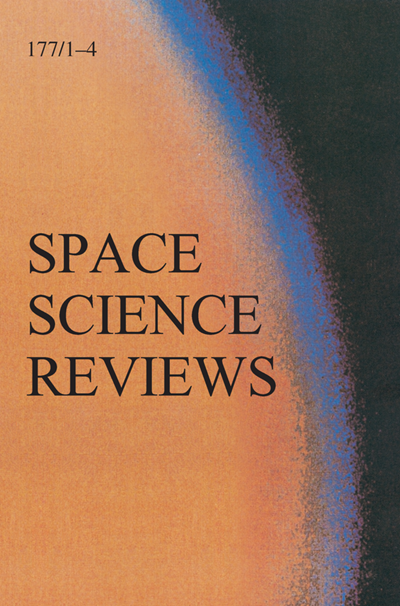The Plasma Instrument for Magnetic Sounding (PIMS) on the Europa Clipper Mission
IF 7.4
2区 物理与天体物理
Q1 ASTRONOMY & ASTROPHYSICS
引用次数: 0
Abstract
Abstract Characterizing Europa’s subsurface ocean is essential for assessing Europa’s habitability. The suite of instruments on the Europa Clipper spacecraft will, among others, magnetically sound Europa’s interior by measuring the ocean’s induced magnetic field. This magnetic field is generated in response to the Jovian time-varying magnetic environment in which Europa is immersed. However, the dynamic magnetized plasma flow of the Jovian magnetosphere creates electrical currents that give rise to magnetic perturbations near Europa. These perturbations complicate the interpretation of the induction signal, and hence the characterization and inferences on potential habitability. Thus, characterization of the ocean by magnetic sounding requires an accurate characterization of the plasma as it flows across Europa. We present the Plasma Instrument for Magnetic Sounding (PIMS), the instrument for the Europa Clipper mission that will measure the plasma contribution to the magnetic field perturbations sensed by the Europa Clipper Magnetometer. PIMS is composed of four Faraday Cup plasma spectrometers that use voltage-biased gridded apertures to dissect the space plasmas that they encounter. The instrument uses sensitive preamplifiers and processing electronics to measure the current that results when charged particles strike the instrument’s metal collector plates, thus enabling a measure of the plasma characteristics near Europa to produce a more accurate magnetic sounding of Europa’s subsurface ocean. PIMS consists of two sensors: one placed near the top of the Europa Clipper spacecraft and one near the bottom. Each sensor contains two Faraday Cups with a 90° full-width field-of-view. The sensors were specifically designed to withstand the Europa environment, measure both ions and electrons, and have two separate voltage ranges intended to analyze the magnetospheric and ionospheric environments, respectively. In this paper, we describe the scientific motivation for this experiment, the design considerations for the PIMS instrument, the details of the ground calibration, and other details pertinent to understanding the scientific data retrieved by PIMS.欧罗巴快船任务中的等离子体磁探测仪器
表征木卫二的地下海洋对于评估木卫二的宜居性至关重要。“木卫二快船”航天器上的整套仪器将通过测量海洋的感应磁场,对木卫二内部进行磁力探测。这个磁场是由于木卫二所处的木星时变磁环境而产生的。然而,木星磁层的动态磁化等离子体流产生了电流,在木卫二附近引起了磁扰动。这些扰动使感应信号的解释复杂化,从而对潜在的可居住性进行表征和推断。因此,通过磁探测对海洋进行表征需要对等离子体在木卫二上的流动进行精确的表征。我们介绍了等离子体磁探测仪器(PIMS),该仪器将用于木卫二快船任务,测量等离子体对由木卫二快船磁强计感知的磁场扰动的贡献。PIMS由四个法拉第杯等离子体光谱仪组成,它们使用电压偏压网格孔来剖析它们遇到的空间等离子体。该仪器使用敏感的前置放大器和处理电子设备来测量带电粒子撞击仪器的金属集电板时产生的电流,从而能够测量木卫二附近的等离子体特性,从而对木卫二地下海洋进行更精确的磁探测。PIMS由两个传感器组成:一个靠近木卫二快船航天器的顶部,另一个靠近底部。每个传感器包含两个具有90°全宽视场的法拉第杯。这些传感器是专门为承受木卫二环境而设计的,可以测量离子和电子,并有两个单独的电压范围,分别用于分析磁层和电离层环境。在本文中,我们描述了本次实验的科学动机、PIMS仪器的设计考虑、地面校准的细节,以及与理解PIMS检索的科学数据有关的其他细节。
本文章由计算机程序翻译,如有差异,请以英文原文为准。
求助全文
约1分钟内获得全文
求助全文
来源期刊

Space Science Reviews
地学天文-天文与天体物理
CiteScore
19.70
自引率
3.90%
发文量
60
审稿时长
4-8 weeks
期刊介绍:
Space Science Reviews (SSRv) stands as an international journal dedicated to scientific space research, offering a contemporary synthesis across various branches of space exploration. Emphasizing scientific outcomes and instruments, SSRv spans astrophysics, physics of planetary systems, solar physics, and the physics of magnetospheres & interplanetary matter.
Beyond Topical Collections and invited Review Articles, Space Science Reviews welcomes unsolicited Review Articles and Special Communications. The latter encompass papers related to a prior topical volume/collection, report-type papers, or timely contributions addressing a robust combination of space science and technology. These papers succinctly summarize both the science and technology aspects of instruments or missions in a single publication.
 求助内容:
求助内容: 应助结果提醒方式:
应助结果提醒方式:


